by Philbert Ono, Updated: Jan. 14, 2024
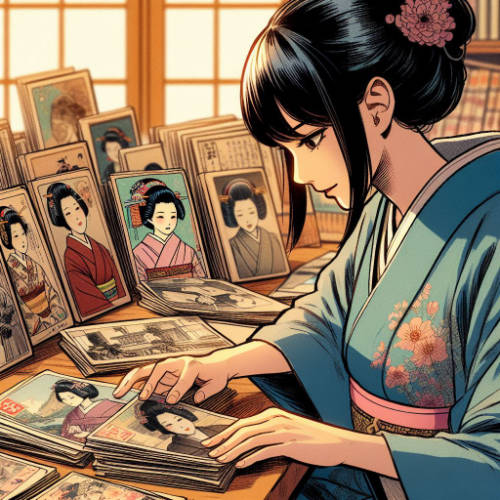
Contents: Early history | How to date Japanese postcards | Year Conversion Table
Early history of Japanese postcards
In September 1870, Japan’s Finance Office was requested to design Japan’s first stamps. The stamps were made in four denominations: 48-mon, 100-mon, 200-mon, and 500-mon. They were hand-engraved and had no perforation on the edges nor any gummed back.
Issued in April 1871, the stamps were used by Japan’s Postal Service which was established in March 1871. When Japan’s monetary system changed in February 1872, the denominations of these four stamps were changed to half sen, 1 sen, 2 sen, and 5 sen and issued in April 1872. Later in September the same year, stamps with 10-sen, 20-sen, and 30-sen denominations were added.
Japan’s first postcard was issued in December 1873. (In Europe, the first postcard was issued a few years earlier.) The card was folded in the middle to give the equivalent of two connected cards. It had instructions printed on the inside saying that only the name and address of the recipient were to be written on the front side and nothing else. (Correspondence had to be written on another side.) Such instructions were necessary since postcards were a new thing to people. Postcards to be sent within city limits cost half sen while those for out of town cost 1 sen. Later, uniform postage rates were implemented.
In May 1875, the two-card, folded postcards were replaced by single cards which retained the instructions to “write only the name and address on the front side.” (The message was written on the back side.) They were priced at half sen and 1 sen. In September 1876, the half-sen cards was changed to 5-rin cards which were discontinued in 1888. In 1898, the 1-sen cards were raised to 1 1/2 sen.
In 1906, the instructions (“write only name and address”) on the front side was deleted and the coloring and design of postcard stamps were improved.
Around 1923 when the Great Kanto Earthquake struck, the postcard size and imprinted stamp got smaller. Rule lines for the name and address were also added. But these cards were unpopular and were discontinued in favor of the old-style cards.
In January 1885, the return-postcard was issued for domestic and international mail. They were two postcards connected as one and folded. It supplied the recipient with a tear-off postcard to send back in response. They cost double the price of single postcards and had a different color (crimson) from ordinary single postcards. In 1899, the price of return-postcards was 3 sen and the color changed to light blue. The color changed again in 1906.
Another type of postcards, called sealed postcards, was introduced in October 1900. Later in 1917 they featured perforations to make unsealing easier.
Japan’s postal service thereby issued four types of postcards: Ordinary postcards, return-postcards, sealed postcards, and international postcards.
In the private sector, a revision of the postal act in 1900 allowed private (non-governmental) postcards to be made and used. Picture postcards then became very popular and gave rise to a new postcard culture and a new era in postal history.
In June 1902, the postal service issued its first commemorative picture postcard. It marked the 25th anniversary of Japan’s membership in the International Postal Union. (Japan’s first commemorative stamps [2 sen and 5 sen] were issued in March 1894. They were for the silver wedding anniversary of Emperor Meiji.)
The postal service later issued more commemorative stamps and postcards for other important events. It also put commemorative postmarks on letters and postcards at the same time. Especially popular were postcards commemorating the enthronement of Emperor Taisho, peace-related events, and triumphs in the Russo-Japanese War during 1904-5.
Postcard popularity reached its peak during the war with Russia when people lined up all night in front of post offices before new war-related commemorative postcards went on sale. People held postcard exchange meetings and many collectors had tens of thousands of postcards. However, after the war ended, the postcard boom waned.
Postcards became popular souvenirs for tourists and an advertising medium for businesses.
How to date vintage Japanese postcards
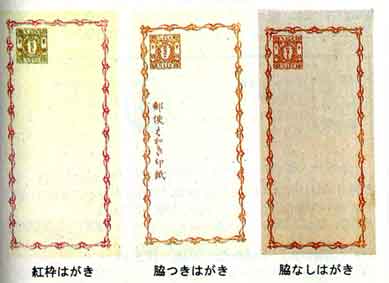
Japan’s Postal Service was first established in March 1871. Japan’s first postcards, pictured above, were issued in December 1873, a few years after the first postcards were issued in Europe.
In 1900, a revision of the postal act allowed private-sector (non-governmental) postcards to be made and used. Picture postcards then became very popular and gave rise to a new postcard culture and a new era in postal history.
The postcards featured a great variety of subjects: Scenics, women, geisha, war, disaster scenes (especially earthquakes), Japanese customs, the Emperor, buildings, animals, etc., etc.
Color printing had not been invented yet so hand-painted postcards became very popular up to around the 1910s when offset printing gradually replaced collotype printing.
In June 1902, the postal service issued its first commemorative picture postcard. It marked the 25th anniversary of Japan’s membership in the International Postal Union.
The postal service later issued more commemorative postcards and stamps for other important events and imprinted commemorative postmarks on letters and postcards for the occasion. Especially popular were postcards commemorating triumphs in the Russo-Japanese War during 1904-5 and the enthronement of Emperor Taisho.
During the war with Russia, people lined up all night in front of post offices before new war-related commemorative postcards went on sale. Postcard exchange meetings were held and many collectors had tens of thousands of postcards. However, after the war ended, the postcard boom waned in Japan.
Meanwhile, foreign tourists visiting Japan continued to send souvenir photographs and postcards back home. Because of them, many of the postcards that were published were able to escape and survive the natural (earthquakes) and man-made (World War II) disasters Japan was to experience later on.
Those early postcards became highly collectible overseas and have continued to delight their owners and collectors for over a century.
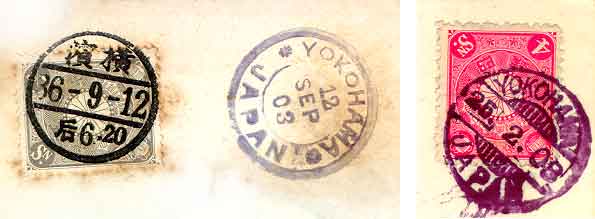
When you want to know how old your postcard is, the first and obvious thing to do is check the postmark if there is one. A postage stamp or written date in the message are also a great help.Because Japan bases its years on the Emperor’s reign (besides using the Western world’s Gregorian calendar), the year of the postmark could refer to the Meiji Era (1868-1912), Taisho Era (1912-1926), Showa Era (1926-1989), or the current Heisei Era (1989-present). So if you see “1” as the year, it could be Year 1 of any of these eras (1868, 1912, 1926, or 1989). (See the year conversion table.)
So how do you determine which era the year refers to? In normal Japanese documents, you would see an initial before the year to indicate the era. For example H.1 for Heisei Year 1 (1989). Unfortunately, none of the postmarks provide an initial for the era. But it is not so hard to determine the era.
Look at the postmark images above. The left postmark is in Japanese with the numbers “36-9-12.” The first number indicates the year, followed by the month and day. Above the date are the kanji characters for “Yokohama.” Below the date is the time the postcard was accepted at the post office (6:20 pm).
Fortunately, right next to this postmark is the English version. The date is September 12, 1903. This matches Year 36 for the Meiji Era in the Japanese postmark. (See the year conversion table.) In case the English postmark were not provided, we could still determine the era. If you look at the year coversion table, you will find that only the Meiji and Showa Eras have a Year 36. Showa 36 is 1961. And if you look at the card and the postage stamp, it is obvious that it is not as recent as 1961, so it must be Meiji 36 (1903).
Now look at the right postmark. This postmark is also in English with the words “Yokohama Japan” in English. The date is “25.2.08.” If the postmark has the location name in English, the date’s format is day-month-Gregorian year, different from the Japanese postmark. So it is February 25, 1908.
Other tidbits about Japanese postmarks:
– In the early years until 1879, postmarks were used to indicate the date of collection and the date of receipt from out of town. Stamp cancellation marks were also separate from postmarks. They could be a series of dotted lines or text like “Postage Paid” (in Japanese). Some postmarks were square in shape. Each postal district had their own postmark system and style.
– In November 1879, the Communications Office issued official recommendations for postmarks. In September 1888, the name of the local area was included in the postmark. By 1909, postmarks became standardized nationwide.
– Up to September 1912, postcards and letters had two postmarks (except for special mail). One was imprinted when the postcard was mailed (canceling the stamp), and another was imprinted when the postcard was received.
– Until 1911, postmarks were imprinted by hand (at a rate of 100 pieces per minute). Automatic postmarking machines were introduced in this year. At the end of 1919, the latest postmarking machines were imported from America and used in Tokyo.
– Stamp collecting is a major hobby in Japan. All the stamps that have ever been issued are documented in a number of comprehensive Japanese stamp catalogs issued every year. You can identify the issue date of any stamp by referring to the stamp catalog.

This is a Japanese postmark with the date reading “2.7.24” and the location being Nikko (read from right to left). The time the postcard was accepted by the post office is indicated below the date.
As with Meiji Era Japanese postmarks (see the preceding section), the date is in the year-month-day format. This can’t be Meiji 2 (1869, before the Japan Post Office was even established), so it must be Taisho 2 (1913) or Showa 2 (1927). My postage stamp catalog tells me that the postage stamp (Chrysanthemum series) was issued in 1899-1907, so it must be Taisho 2. This is confirmed by the English postmark elsewhere on the card.
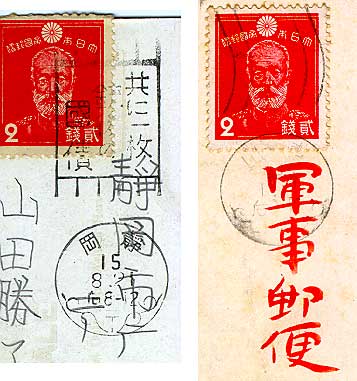
The Showa Era was 1926 to 1989 (Showa 1 to 64) during the reign of Emperor Hirohito. On the left, you can see a Showa Era postmark (round). Notice how different it looks compared with the hand-stamped Meiji and Taisho Era postmarks (see preceding images). The lines and markings are much thinner, imprinted by a postmarking machine (introduced in Japan at the end of 1919).
The location reads “Shizuoka” (from right to left), and below that is the year 15, then 8.21 (month and day), then the time period (8-12 pm) when the card was mailed. Showa 15 is 1940.
The postage stamp was canceled by a separate canceling mark. The stamp was issued in 1937, proof positive that the card is from the Showa Era.
On the right is a Showa Era postmark too light to be legible. But the stamp tells us the approximate date (around 1937). Also, the kanji characters in red says “Gunji Yubin” (軍事郵便) which means military mail.
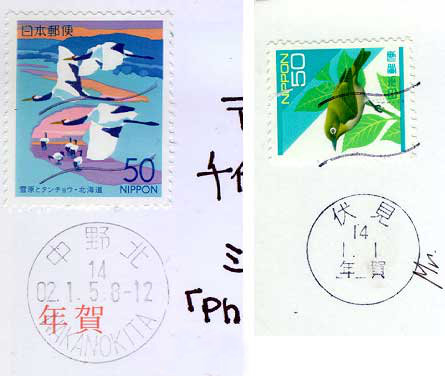
We are currently in the Heisei Era that started in 1989 when Emperor Hirohito died and his son Akihito became the emperor.On the left is a recent postmark. It follows an ideal format. The location (Nakano Kita) is in both Japanese (read from left to right) and English. The year is in both Heisei and Gregorian. The “14” is for Heisei 14 which is 2002. In the middle, the numbers “02.1.5” is for Jan. 1, 2002. And on the right, “8-12” indicates the time period (8 am to 12 noon) when the postcard was mailed. This is nice.
But the postmark on the right is more abbreviated, showing only the location, Heisei year, month, and day.
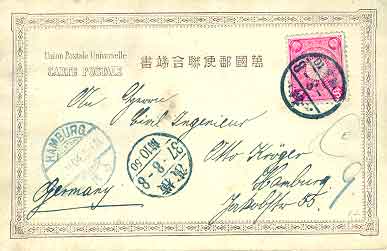
The earliest Japanese tourist postcards had a picture side and an address side. The message had to be written on the picture side which usually had a large white area to write on (like this postcard).
Since the address side was only for the recipient’s address, it had no dividing line for the address and message. This was called an undivided back, and this type of postcards were produced between 1900 (Meiji 33) and March 28, 1907 (Meiji 40) in Japan. After this date, the message was allowed to be written on the address side. See the next image.
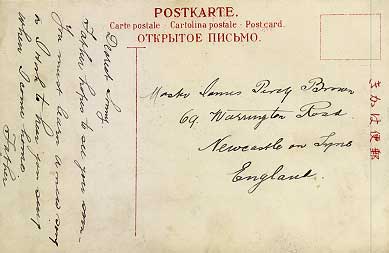
After March 28, 1907 when the message was allowed to be written on the address side, a dividing line was printed on the address side to separate the message and recipient’s address.
However, this line was not at the center of the card. Only one-third of the card could be used for message writing and the other two-thirds portion was reserved for the name and address. Such postcards with an off-center divider were made between March 28, 1907 (Meiji 40) and March 1, 1918 (Taisho 7). From March 1, 1918, the dividing line was moved to the center of the card. (See the next image.)
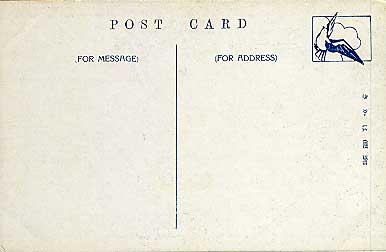
From March 1, 1918, the dividing line moved to the center of the card to separate the message and recipient’s address.
In this way, if the postcard has no postmark or stamp, you can still estimate the date of the card by checking the address side and see if there is a divider or not, an off-center divider, or a center divider.
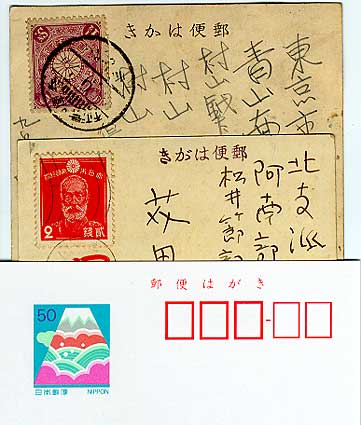
All postcards were required to bear the words Yubin Hagaki (or Hakaki) which means “Post Card.” The words appeared on the address side of the card along the right edge of the horizontal card.This string of Japanese kanji characters underwent two changes during Japan’s postcard history. (If you don’t read Japanese, it might be a little difficult to understand the changes.)
The image above shows a closeup of three postcards. At the top, Yubin Hakaki is read from right to left.
On February 15, 1933, the word Hakaki (はかき) was changed to read Hagaki (はがき) as shown by the middle card above. Then after World War II ended in 1945, the Japanese reading style from right to left changed to left to right (when written horizontally) similar to English. Japanese captions on the picture side also changed to read from left to right after 1945.
Also note that from July 22, 1905, private postcards were allowed to have a foreign-language designation (i.e. “Carte Postale” or “Post Card”) in addition to the Japanese Yubin hakaki.
On the bottom card, notice the five red boxes. They are for the postal code within Japan. From Feb. 1998, Japan’s postal code system was expanded to seven digits. Postcards having seven red boxes were made after Feb 1998. (See next image.)
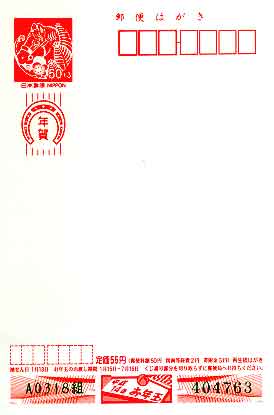
New Year’s postcard. New Year’s postcards are by far the most popular type of postcards in Japan, akin to Christmas cards in the West. The bulk of the cards are delivered on New Year’s Day.The bulk of the cards are delivered on New Year’s Day, and cards which were sent late arrive during the first week of January. The custom of sending New Year’s postcards began almost the same year when postcards were first made in Japan in 1873.
The card above was issued by the Japan Post Office in 2001. This is the address side of the card. The address side is considered to be the front side, and it is designed for the address to be written vertically from top to bottom, right to left. However, there’s no problem with writing it horizontally which looks less formal, nor affixing an address label which looks less personal.
The seven red boxes at the top are for the postal code within Japan. Prior to Feb. 1998 when the postal code was expanded to seven digits, there were only five boxes for the postal code. The stamp is already printed on the card on the upper left corner. The price of the card includes the stamp which happens to be the same price as the card. On the bottom right corner is a lottery number for prizes.
Writing New Year’s cards can be fun, but for many people it is a time-consuming chore if they do it at all. So it is common now to print out messages and addresses with an ink-jet printer at home. The Japan Post Office even offers New Year’s cards made of paper suited for inkjet printing. The inkjet cards make the inkjet printout look a lot better than with cards made of regular paper. If you plan to use an inkjet printer, be sure to purchase the inkjet New Year’s cards.
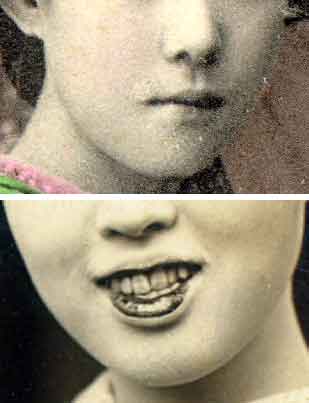
Both images above are magnified by 650%. The top image sample is a collotype image, hand-colored. The photograph in early postcards printed by collotype had very fine grain.However, collotype was not suitable for high-volume printing and it was soon replaced by offset printing from the 1910s.
The bottom image is from a real-photo postcard. It was an actual photograph printed on paper as a postcard. These are easy to recognize with their characteristic sheen or gloss. The grain is the finest of all.
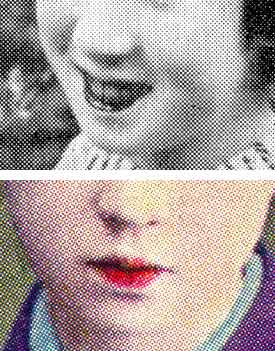
Latter postcard image quality. Offset printing replaced the collotype and color printing came to fore from the 1930s. You can see how the little dots composed the picture. (Magnified by 650%.)
Japanese Year Conversion Table
Since 1868, when Japan switched rulers from a shogun to an emperor, there have been five reigning Emperors: Meiji, Taisho, Hirohito (Showa), Akihito (Heisei), and Naruhito (Reiwa). Japan’s traditional era is based on the emperor’s reign. This table shows the era year and the Gregorian calendar equivalent. Note that in a transition year, it becomes the last year of the preceding era as well as the first year of the new era.
Currently it is the Reiwa Period since May 1, 2019. To calculate its Gregorian calendar equivalent, just add 18. For example, Reiwa 2 is ’20 (2020). For Heisei, add 88. For a Showa year, add 25.
To postcard collectors: Often times, the era name is not mentioned in the postmark. You will have to use other identity points to determine the year. For example, 14.7.6 could be July 6, 1881 or 1925 or 1939. In most cases, it is easy to determine the proper year.
| Meiji 1 = 1868.10.23 Meiji 2 = 1869 Meiji 3 = 1870 Meiji 4 = 1871 Meiji 5 = 1872 Meiji 6 = 1873 Meiji 7 = 1874 Meiji 8 = 1875 Meiji 9 = 1876 Meiji 10 = 1877 Meiji 11 = 1878 Meiji 12 = 1879 Meiji 13 = 1880 Meiji 14 = 1881 Meiji 15 = 1882 |
Meiji 16 = 1883 Meiji 17 = 1884 Meiji 18 = 1885 Meiji 19 = 1886 Meiji 20 = 1887 Meiji 21 = 1888 Meiji 22 = 1889 Meiji 23 = 1890 Meiji 24 = 1891 Meiji 25 = 1892 Meiji 26 = 1893 Meiji 27 = 1894 Meiji 28 = 1895 Meiji 29 = 1896 Meiji 30 = 1897 |
Meiji 31 = 1898 Meiji 32 = 1899 Meiji 33 = 1900 Meiji 34 = 1901 Meiji 35 = 1902 Meiji 36 = 1903 Meiji 37 = 1904 Meiji 38 = 1905 Meiji 39 = 1906 Meiji 40 = 1907 Meiji 41 = 1908 Meiji 42 = 1909 Meiji 43 = 1910 Meiji 44 = 1911 Meiji 45 = 1912.7.30 |
Taisho 1 = 1912.7.30 Taisho 2 = 1913 Taisho 3 = 1914 Taisho 4 = 1915 Taisho 5 = 1916 Taisho 6 = 1917 Taisho 7 = 1918 Taisho 8 = 1919 Taisho 9 = 1920 Taisho 10 = 1921 Taisho 11 = 1922 Taisho 12 = 1923 Taisho 13 = 1924 Taisho 14 = 1925 Taisho 15 =1926.12.25 |
| Showa 1 = 1926.12.25 Showa 2 = 1927 Showa 3 = 1928 Showa 4 = 1929 Showa 5 = 1930 Showa 6 = 1931 Showa 7 = 1932 Showa 8 = 1933 Showa 9 = 1934 Showa 10 = 1935 Showa 11 = 1936 Showa 12 = 1937 Showa 13 = 1938 Showa 14 = 1939 Showa 15 = 1940 Showa 16 = 1941 Showa 17 = 1942 Showa 18 = 1943 Showa 19 = 1944 Showa 20 = 1945 Showa 21 = 1946 Showa 22 = 1947 Showa 23 = 1948 Showa 24 = 1949 Showa 25 = 1950 Showa 26 = 1951 Showa 27 = 1952 Showa 28 = 1953 Showa 29 = 1954 Showa 30 = 1955 Showa 31 = 1956 Showa 32 = 1957 |
Showa 33 = 1958 Showa 34 = 1959 Showa 35 = 1960 Showa 36 = 1961 Showa 37 = 1962 Showa 38 = 1963 Showa 39 = 1964 Showa 40 = 1965 Showa 41 = 1966 Showa 42 = 1967 Showa 43 = 1968 Showa 44 = 1969 Showa 45 = 1970 Showa 46 = 1971 Showa 47 = 1972 Showa 48 = 1973 Showa 50 = 1975 Showa 51 = 1976 Showa 52 = 1977 Showa 53 = 1978 Showa 54 = 1979 Showa 55 = 1980 Showa 56 = 1981 Showa 57 = 1982 Showa 58 = 1983 Showa 59 = 1984 Showa 60 = 1985 Showa 61 = 1986 Showa 62 = 1987 Showa 63 = 1988 Showa 64 = 1989.1.7 |
Heisei 1 = 1989.1.8 Heisei 2 = 1990 Heisei 3 = 1991 Heisei 4 = 1992 Heisei 5 = 1993 Heisei 6 = 1994 Heisei 7 = 1995 Heisei 8 = 1996 Heisei 9 = 1997 Heisei 10 = 1998 Heisei 11 = 1999 Heisei 12 = 2000 Heisei 13 = 2001 Heisei 14 = 2002 Heisei 15 = 2003 Heisei 16 = 2004 Heisei 17 = 2005 Heisei 18 = 2006 Heisei 19 = 2007 Heisei 20 = 2008 Heisei 21 = 2009 Heisei 22 = 2010 Heisei 23 = 2011 Heisei 24 = 2012 Heisei 25 = 2013 Heisei 26 = 2014 Heisei 27 = 2015 Heisei 28 = 2016 Heisei 29 = 2017 Heisei 30 = 2018 Heisei 31 = 2019.4.30 |
Reiwa 1 = 2019.5.1 Reiwa 2 = 2020 Reiwa 3 = 2021 Reiwa 4 = 2022 Reiwa 5 = 2023 Reiwa 6 = 2024 Reiwa 7 = 2025 Reiwa 8 = 2026 Reiwa 9 = 2027 Reiwa 10 = 2028 Reiwa 11 = 2029 Reiwa 12 = 2030 Reiwa 13 = 2031 Reiwa 14 = 2032 Reiwa 15 = 2033 Reiwa 16 = 2034 Reiwa 17 = 2035 Reiwa 18 = 2036 Reiwa 19 = 2037 Reiwa 20 = 2038 |